Lyda Borelli (1887-1959) was the first Italian film diva. La Borelli was already an acclaimed stage actress before she became a star of the Italian silent cinema. The fascinating diva caused a craze among female fans, which was called 'Borellismo'.

Italian postcard, no. 600. Photo: Emilio Sommariva, Milano. Lyda Borelli in Oscar Wilde's stage play 'Salome'.

Italian postcard by Ed. A Traldi, Milano, no. 597. Photo: Emilio Sommariva, Milano.

Italian postcard, no. 603. Photo: Emilio Sommariva, Milano. Lyda Borelli in an outfit for Oscar Wilde's stage play 'Salome'. Collection: Marlene Pilaete.

Italian postcard by Neg. Trevisani, Bologna, no. 459.
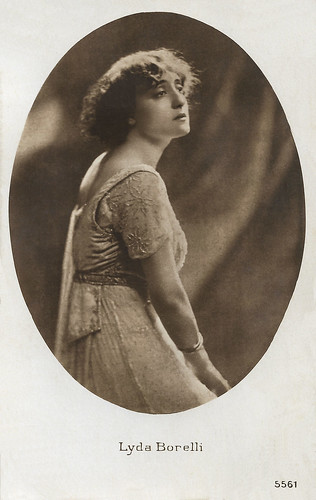
German postcard, no. 5561.

Italian postcard by N. Riccardi, Milano, Serie 7458 - F. Lyda Borelli was written as Lidia Borelli. Ca. 1910.

Italian postcard, Ufficio Censura Torino, 9-10-1915, no. 6184. Photo: Lyda Borelli in the Italian silent film Marcia Nuziale (Carmine Gallone, 1915), one of the few lost films of her career.

Italian postcard. Photo: Emilio Sommariva, Milano, no. 504. Collection: Didier Hanson.
Lyda Borelli was born in 1884 in Rivarolo Ligure near Genoa in Italy. She was the daughter of the stage actors Napoleone Borelli and Cesira Banti. Both her parents were theatre actors and it was only natural for Lyda to follow her parents’ steps. Her sister Alda Borelli would later also become a well-known actress.
At 17, Lyda made her stage debut in 1902 with the Pasta-Reiter company. She acted with Paola Pezzaglia in the French drama I due derelitti. Later, she switched to the company of Virgina Talli.
At the age of 18, she already played leads, as in Gabriele d'Annunzio's 'La figlia di Jorio' (The Daughter of Jorio, 1904). The decadent poet and writer later dedicated her 'Il ferro' and 'Più che l’amore'.
In 1909 Borelli started her own company with Ruggero Ruggeri, performing both in light comedies and in such serious dramas as 'Salome' by Oscar Wilde, which would be her major stage play.
In 1909 Ruggeri and Borelli did a tour through Latin America visiting a.o. Argentine, Uruguay, Brazil, Cuba, and Mexico. In 1914 she would return to Latin America for another tour.
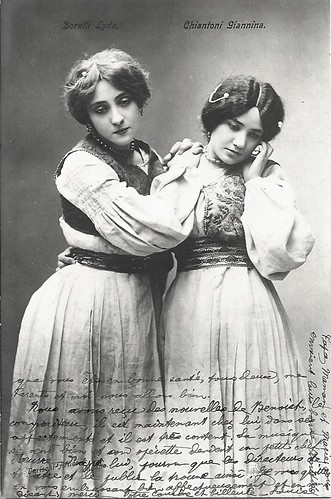
Italian postcard by Varischi & Artico, Milano. Lyda Borelli and Giannina Chiantoni in Gabriele D'Annunzio's stage play 'La figlia di Jorio' (1904).

Italian postcard, no. 623. Photo Sciutto. Could have been for the stage play 'La figlia di Jorio' by Gabriele D'Annunzio.
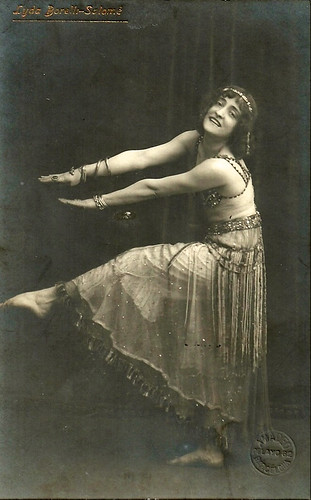
Spanish postcard by Amadeo, Barcelona. Lyda Borelli in her outfit for her stage version of Oscar Wilde's 'Salomé'.
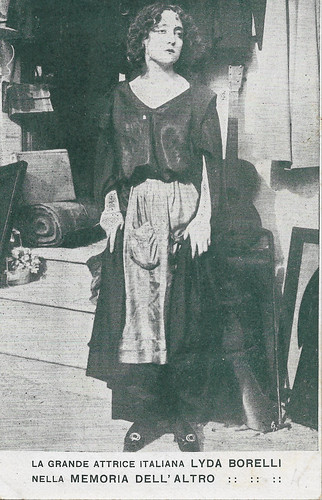
Italian postcard by Stab. Tip. Valdiserra, Pescia for the Cinematografo Massimo Libia, Piazza Cavour, Firenze (Florence). Photo: Gloria Film. Lyda Borelli in La memoria dell'altro (Alberto Degli Abbati, 1913).

Italian postcard by Uff. Rev. St. Terni, no. 3276. Photo: Film Cines. Lyda Borelli in the silent film Madame Tallien (Mario Caserini, Enrico Guazzoni, 1916), based on the play by Victorien Sardou. The caption goes: "Desfieux, Tallien's Head of Police, runs to Therese's house, discovers the hideout of Jean Guery and has all arrested".
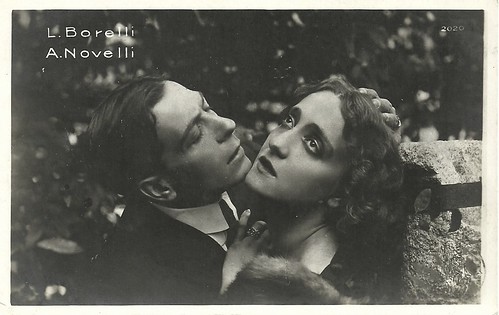
Italian postcard. Photo: Lyda Borelli and Amleto Novelli in the silent film Malombra (Carmine Gallone, 1917).

Spanish postcard. Photo: dressed as Salome, Alba d'Oltrevita (Lyda Borelli) repents the suicide of Sergio because of her in Rapsodia satanica (Nino Oxilia, 1915-1917).

Spanish chocolate card by Imperial. Photo: publicity still of Lyda Borelli in Il dramma di una note/The Drama of a Night (Mario Caserini, 1918).
In 1913 the film Ma l'amor mio non muore/Love Everlasting (Mario Caserini, 1913) was designed to launch Lydia Borelli in the cinema. The film, made in Turin by Gloria Film, tells the story of a singer who falls tragically in love with a prince, played by Mario Bonnard. Her ecstatic and aristocratic performance, mixing grand gestures with delicate small details, her elegant attire and her long blond hair caused a craze. Girls dyed their hair, went on diets and strove to imitate her twisted postures. The craze was called 'Borellismo' in Italy.
With the possible exception of the epic Cabiria (1914), Ma l'amor mio non muore is seen by critics as the most famous of early Italian silent films made before World War I. Borelli's appearance in the film led to her being considered the first diva of the cinema.
The worldwide success of Ma l'amor mio non muore resulted in thirteen more films with Borelli. In these films, Lyda Borelli portrayed characters who were doomed and otherworldly, often bordering on the supernatural. She had a favourite fashion designer, artist Mariano Fortuny (admired also by Eleonora Duse) and deemed his creations as vital in her films
A compelling film is her drama Rapsodia Satanica/Satanic Rhapsody (Nino Oxilia, 1915) which tells the tale of an old woman who makes a pact with the Devil for eternal youth. his female version of Faust was based on a poem by Fausto Maria Martini.
Famous composer Pietro Mascagni wrote his only film music for Rapsodia Satanica and conducted the first performance in July 1917. Mascagni was keen to take the commission for the score due to the financial burden of supporting two sickening brothers. Lyda Borelli's best films also include La donna nuda/The Naked Truth (1914), Fior di male/Flower of Evil (1915), and Malombra (1917), all three directed by Carmine Gallone.

Italian postcard, no. 477. Photo: Attilio Badodi. Signed: Lyda Borelli. Attilio Badodi (1880-1967), born in Reggio Emilia, became a famous Milanese portrait photographer of the Belle Epoque. In 1922 he participated in the First International Exhibition on Photography in Turin and he was a reporter for Illustrazione Italiana, but he is best remembered for his portraits.

Italian postcard, no. 319. Photo: Attilio Badodi, Milano (Milan).

Italian postcard by Fotocelere, Torino, no. 207. Photo: Badodi, Milano.

Italian postcard, no. 256. Photo: Attilio Badodi, Milano (Milan).
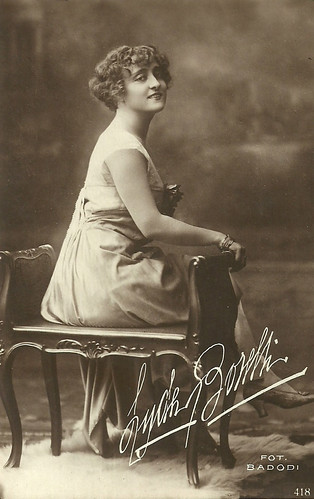
Italian postcard, no. 418. Photo: Attilio Badodi, Milano (Milan).

Italian postcard, no. 118. Photo: Bettini, Roma.
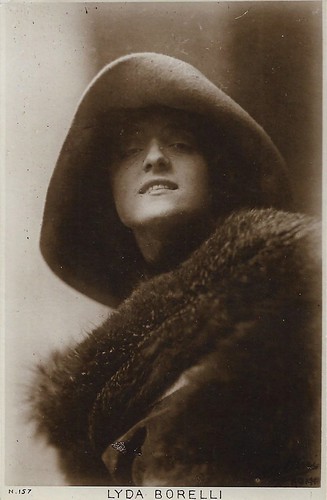
Italian postcard, no. 157. Photo: Bettini, Rome.
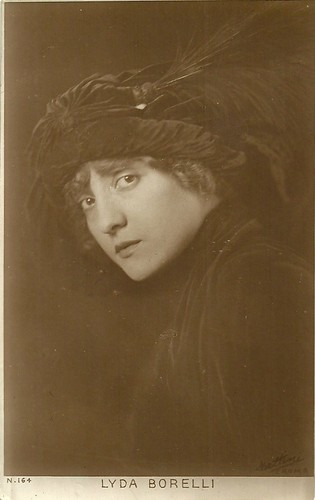
Italian postcard. Ed. Soc. Anon. It., no. 164. Photo: Bettini, Roma.
Lyda Borelli was the first diva of Italian cinema and one of the first European film stars, together with Asta Nielsen. Greta de Groot at Unsung Divas: "She was like a decadent version of the Pre-Raphaelite beauty--thin, with wavy blond hair and strange but picturesque poses. She portrayed characters who were doomed and otherworldly, often bordering on the supernatural."
Anna Battista at her blog Irenebrination sees her essentially as 'a dark femme fatale representing desire and sensuality': "She often interpreted characters defeated by diabolical destinies who ended up killing themselves (often with poison – she died in 8 out of 14 films…)."
In 1918 Lyda Borelli's stage and film career ended suddenly when she married the Venetian businessman and later count Vittorio Cini di Monselice. Between 1914 and 1918 she had shot 14 films and 2 documentaries. Anna Battista: "The legend says that when the curtain fell at the end of her last play, people in the audience started crying and throwing her flowers: it was almost unbelievable for them to think that Lyda Borelli had just acted for the last time and some critics wrote that was a national day of mourning."
In the following years, the couple Cini would have four children, Giorgio, Mynna, Yana and Ylda, and Lyda devoted her time to her family. They lived between Venice and Rome. The Borellismo trend had disappeared soon after the actress retired. Borelli's son Giorgio Cini would die in a plane crash while going to meet his fiancee, the actress Merle Oberon. Lyda herself died in 1959 in Rome, Lazio, Italy. She was 75.
Borelli was one of the divas featured in the compilation film Diva Dolorosa (Peter Delpeut, 1999). An extended sequence from Fior de Male appears in Peter Delpeut's earlier film Lyrisch Nitraat/Lyrical Nitrate (Peter Delpeut, 1991). In 2013 the Cineteca di Bologna released a DVD of Ma l'amor mio non muore, and in 2018 a box including Ma l'amor mio non muore and Rapsodia satanica. Antonio Gramsci, at the time a theatre reviewer, wrote in Avanti! about her: "La Borelli è l'artista per eccellenza del film in cui la lingua è il corpo umano nella sua plasticità sempre rinnovantesi" (La Borelli is the film artist par excellence whose language is the human body in its always renewing plasticity).

Italian postcard. Photo: Varischi & Artico, Milano.
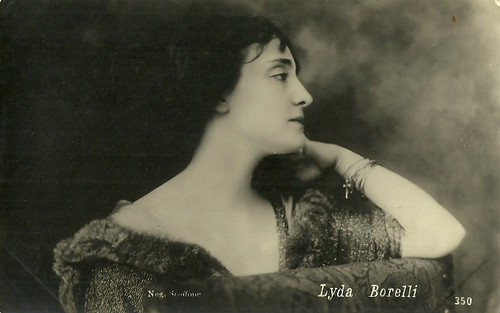
Italian postcard by Ballerini & Fratini, Firenze, no. 350. Photo: Scoffone.
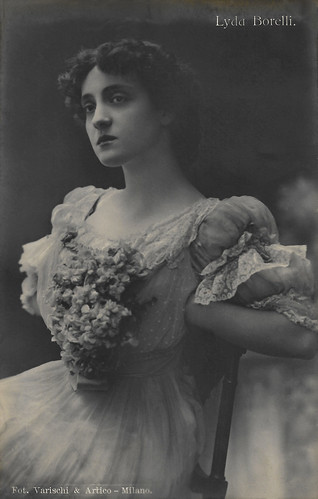
Italian postcard. Photo: Varischi & Artico, Milano.

Italian postcard, no. 2015. Photo: Varischi Artico & Co., Milano.

Italian postcard by Ed. A. Traldi, Milano, no. 323. Photo: Fontana.
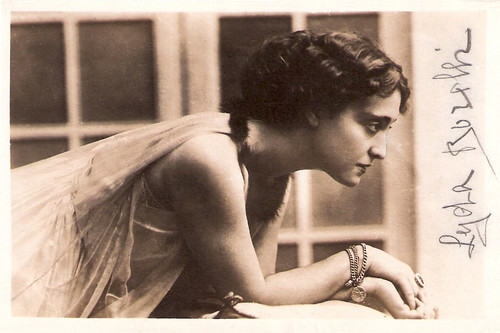
Italian postcard by A.G.F. Photo: Cine.

Italian postcard, no. 894, Uff. Rev. Stampa, 25-5-1917. Lyda Borelli painted by Tito Corbella.

Italian postcard. Lyda Borelli, caricature by C. Calderara. Looking at the outfit and the headgear, the drawing seems to refer to Borelli's first film Ma l'amor mio non muore/ Love Everlasting (1913).
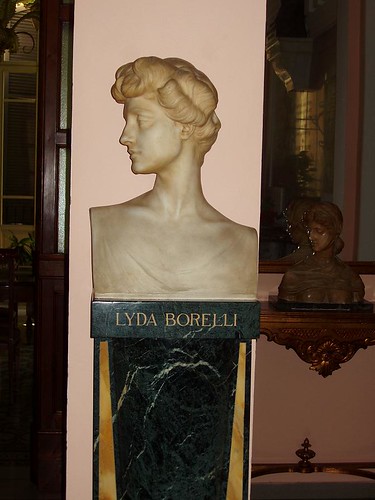
Statue of Lyda Borelli in the Casa di Riposo 'Lyda Borelli', Bologna, Italy. Photo: Ivo Blom.
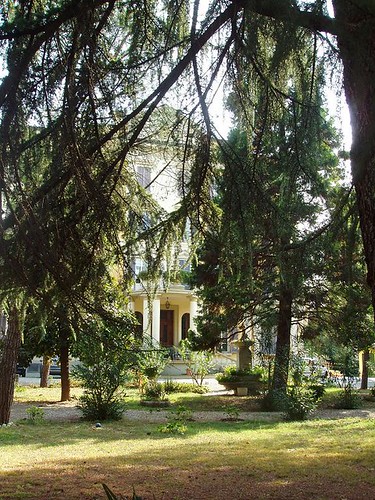
Casa di Riposo 'Lyda Borelli', Bologna, Italy. Photo: Ivo Blom.
Sources: Biblioteca e Raccolta Teatrale del Burcardo, Greta De Groat (Unsung Divas), Anna Battista (Irenebrination), Wikipedia (English and Italian) and IMDb.
This post was last updated on 10 July 2023.

Italian postcard, no. 600. Photo: Emilio Sommariva, Milano. Lyda Borelli in Oscar Wilde's stage play 'Salome'.

Italian postcard by Ed. A Traldi, Milano, no. 597. Photo: Emilio Sommariva, Milano.

Italian postcard, no. 603. Photo: Emilio Sommariva, Milano. Lyda Borelli in an outfit for Oscar Wilde's stage play 'Salome'. Collection: Marlene Pilaete.

Italian postcard by Neg. Trevisani, Bologna, no. 459.

German postcard, no. 5561.

Italian postcard by N. Riccardi, Milano, Serie 7458 - F. Lyda Borelli was written as Lidia Borelli. Ca. 1910.

Italian postcard, Ufficio Censura Torino, 9-10-1915, no. 6184. Photo: Lyda Borelli in the Italian silent film Marcia Nuziale (Carmine Gallone, 1915), one of the few lost films of her career.

Italian postcard. Photo: Emilio Sommariva, Milano, no. 504. Collection: Didier Hanson.
The decadent D'Annunzio
Lyda Borelli was born in 1884 in Rivarolo Ligure near Genoa in Italy. She was the daughter of the stage actors Napoleone Borelli and Cesira Banti. Both her parents were theatre actors and it was only natural for Lyda to follow her parents’ steps. Her sister Alda Borelli would later also become a well-known actress.
At 17, Lyda made her stage debut in 1902 with the Pasta-Reiter company. She acted with Paola Pezzaglia in the French drama I due derelitti. Later, she switched to the company of Virgina Talli.
At the age of 18, she already played leads, as in Gabriele d'Annunzio's 'La figlia di Jorio' (The Daughter of Jorio, 1904). The decadent poet and writer later dedicated her 'Il ferro' and 'Più che l’amore'.
In 1909 Borelli started her own company with Ruggero Ruggeri, performing both in light comedies and in such serious dramas as 'Salome' by Oscar Wilde, which would be her major stage play.
In 1909 Ruggeri and Borelli did a tour through Latin America visiting a.o. Argentine, Uruguay, Brazil, Cuba, and Mexico. In 1914 she would return to Latin America for another tour.

Italian postcard by Varischi & Artico, Milano. Lyda Borelli and Giannina Chiantoni in Gabriele D'Annunzio's stage play 'La figlia di Jorio' (1904).

Italian postcard, no. 623. Photo Sciutto. Could have been for the stage play 'La figlia di Jorio' by Gabriele D'Annunzio.

Spanish postcard by Amadeo, Barcelona. Lyda Borelli in her outfit for her stage version of Oscar Wilde's 'Salomé'.

Italian postcard by Stab. Tip. Valdiserra, Pescia for the Cinematografo Massimo Libia, Piazza Cavour, Firenze (Florence). Photo: Gloria Film. Lyda Borelli in La memoria dell'altro (Alberto Degli Abbati, 1913).

Italian postcard by Uff. Rev. St. Terni, no. 3276. Photo: Film Cines. Lyda Borelli in the silent film Madame Tallien (Mario Caserini, Enrico Guazzoni, 1916), based on the play by Victorien Sardou. The caption goes: "Desfieux, Tallien's Head of Police, runs to Therese's house, discovers the hideout of Jean Guery and has all arrested".

Italian postcard. Photo: Lyda Borelli and Amleto Novelli in the silent film Malombra (Carmine Gallone, 1917).

Spanish postcard. Photo: dressed as Salome, Alba d'Oltrevita (Lyda Borelli) repents the suicide of Sergio because of her in Rapsodia satanica (Nino Oxilia, 1915-1917).

Spanish chocolate card by Imperial. Photo: publicity still of Lyda Borelli in Il dramma di una note/The Drama of a Night (Mario Caserini, 1918).
Worldwide success
In 1913 the film Ma l'amor mio non muore/Love Everlasting (Mario Caserini, 1913) was designed to launch Lydia Borelli in the cinema. The film, made in Turin by Gloria Film, tells the story of a singer who falls tragically in love with a prince, played by Mario Bonnard. Her ecstatic and aristocratic performance, mixing grand gestures with delicate small details, her elegant attire and her long blond hair caused a craze. Girls dyed their hair, went on diets and strove to imitate her twisted postures. The craze was called 'Borellismo' in Italy.
With the possible exception of the epic Cabiria (1914), Ma l'amor mio non muore is seen by critics as the most famous of early Italian silent films made before World War I. Borelli's appearance in the film led to her being considered the first diva of the cinema.
The worldwide success of Ma l'amor mio non muore resulted in thirteen more films with Borelli. In these films, Lyda Borelli portrayed characters who were doomed and otherworldly, often bordering on the supernatural. She had a favourite fashion designer, artist Mariano Fortuny (admired also by Eleonora Duse) and deemed his creations as vital in her films
A compelling film is her drama Rapsodia Satanica/Satanic Rhapsody (Nino Oxilia, 1915) which tells the tale of an old woman who makes a pact with the Devil for eternal youth. his female version of Faust was based on a poem by Fausto Maria Martini.
Famous composer Pietro Mascagni wrote his only film music for Rapsodia Satanica and conducted the first performance in July 1917. Mascagni was keen to take the commission for the score due to the financial burden of supporting two sickening brothers. Lyda Borelli's best films also include La donna nuda/The Naked Truth (1914), Fior di male/Flower of Evil (1915), and Malombra (1917), all three directed by Carmine Gallone.

Italian postcard, no. 477. Photo: Attilio Badodi. Signed: Lyda Borelli. Attilio Badodi (1880-1967), born in Reggio Emilia, became a famous Milanese portrait photographer of the Belle Epoque. In 1922 he participated in the First International Exhibition on Photography in Turin and he was a reporter for Illustrazione Italiana, but he is best remembered for his portraits.

Italian postcard, no. 319. Photo: Attilio Badodi, Milano (Milan).

Italian postcard by Fotocelere, Torino, no. 207. Photo: Badodi, Milano.

Italian postcard, no. 256. Photo: Attilio Badodi, Milano (Milan).

Italian postcard, no. 418. Photo: Attilio Badodi, Milano (Milan).

Italian postcard, no. 118. Photo: Bettini, Roma.

Italian postcard, no. 157. Photo: Bettini, Rome.

Italian postcard. Ed. Soc. Anon. It., no. 164. Photo: Bettini, Roma.
A decadent version of the Pre-Raphaelite beauty
Lyda Borelli was the first diva of Italian cinema and one of the first European film stars, together with Asta Nielsen. Greta de Groot at Unsung Divas: "She was like a decadent version of the Pre-Raphaelite beauty--thin, with wavy blond hair and strange but picturesque poses. She portrayed characters who were doomed and otherworldly, often bordering on the supernatural."
Anna Battista at her blog Irenebrination sees her essentially as 'a dark femme fatale representing desire and sensuality': "She often interpreted characters defeated by diabolical destinies who ended up killing themselves (often with poison – she died in 8 out of 14 films…)."
In 1918 Lyda Borelli's stage and film career ended suddenly when she married the Venetian businessman and later count Vittorio Cini di Monselice. Between 1914 and 1918 she had shot 14 films and 2 documentaries. Anna Battista: "The legend says that when the curtain fell at the end of her last play, people in the audience started crying and throwing her flowers: it was almost unbelievable for them to think that Lyda Borelli had just acted for the last time and some critics wrote that was a national day of mourning."
In the following years, the couple Cini would have four children, Giorgio, Mynna, Yana and Ylda, and Lyda devoted her time to her family. They lived between Venice and Rome. The Borellismo trend had disappeared soon after the actress retired. Borelli's son Giorgio Cini would die in a plane crash while going to meet his fiancee, the actress Merle Oberon. Lyda herself died in 1959 in Rome, Lazio, Italy. She was 75.
Borelli was one of the divas featured in the compilation film Diva Dolorosa (Peter Delpeut, 1999). An extended sequence from Fior de Male appears in Peter Delpeut's earlier film Lyrisch Nitraat/Lyrical Nitrate (Peter Delpeut, 1991). In 2013 the Cineteca di Bologna released a DVD of Ma l'amor mio non muore, and in 2018 a box including Ma l'amor mio non muore and Rapsodia satanica. Antonio Gramsci, at the time a theatre reviewer, wrote in Avanti! about her: "La Borelli è l'artista per eccellenza del film in cui la lingua è il corpo umano nella sua plasticità sempre rinnovantesi" (La Borelli is the film artist par excellence whose language is the human body in its always renewing plasticity).

Italian postcard. Photo: Varischi & Artico, Milano.

Italian postcard by Ballerini & Fratini, Firenze, no. 350. Photo: Scoffone.

Italian postcard. Photo: Varischi & Artico, Milano.

Italian postcard, no. 2015. Photo: Varischi Artico & Co., Milano.

Italian postcard by Ed. A. Traldi, Milano, no. 323. Photo: Fontana.

Italian postcard by A.G.F. Photo: Cine.

Italian postcard, no. 894, Uff. Rev. Stampa, 25-5-1917. Lyda Borelli painted by Tito Corbella.

Italian postcard. Lyda Borelli, caricature by C. Calderara. Looking at the outfit and the headgear, the drawing seems to refer to Borelli's first film Ma l'amor mio non muore/ Love Everlasting (1913).

Statue of Lyda Borelli in the Casa di Riposo 'Lyda Borelli', Bologna, Italy. Photo: Ivo Blom.

Casa di Riposo 'Lyda Borelli', Bologna, Italy. Photo: Ivo Blom.
Sources: Biblioteca e Raccolta Teatrale del Burcardo, Greta De Groat (Unsung Divas), Anna Battista (Irenebrination), Wikipedia (English and Italian) and IMDb.
This post was last updated on 10 July 2023.
2 comments:
Oh, Paul! These are incredible! What an interesting woman she was. I often use old photos such as these as reference for my artwork.
There's something so elegant and beautiful about the women of that era.
Have a lovely day, and thank you for joining us for Postcard Friendship Friday!
Always fun to visit (its been awhile!). She was a lovely woman -- had a beautiful smile. Happy PFF
Post a Comment